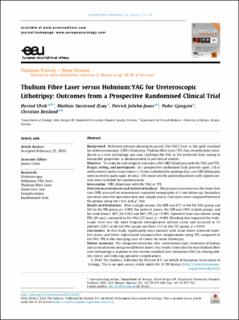| dc.contributor.author | Ulvik, Øyvind | |
| dc.contributor.author | Æsøy, Mathias S. | |
| dc.contributor.author | Jones, Charles Patrick Warburton | |
| dc.contributor.author | Gjengstø, Peder | |
| dc.contributor.author | Beisland, Christian | |
| dc.date.accessioned | 2022-08-10T07:21:59Z | |
| dc.date.available | 2022-08-10T07:21:59Z | |
| dc.date.created | 2022-04-27T12:11:45Z | |
| dc.date.issued | 2022 | |
| dc.identifier.issn | 0302-2838 | |
| dc.identifier.uri | https://hdl.handle.net/11250/3010970 | |
| dc.description.abstract | Background
Holmium:yttrium-aluminium-garnet (Ho:YAG) laser is the gold standard for ureterorenoscopic (URS) lithotripsy. Thulium fibre laser (TFL) has recently been introduced as a new technology and may challenge Ho:YAG as the preferred laser owing to favourable properties as demonstrated in preclinical studies.
Objective
To evaluate and compare outcomes after URS lithotripsy with Ho:YAG and TFL.
Design, setting, and participants
In a prospective randomised trial, patients aged ≥18 yr with ureteral and/or renal stones (≥5 mm) scheduled to undergo day-case URS lithotripsy were invited to participate. In total, 120 consecutively admitted patients with signed consent were included for randomisation.
Intervention
URS lithotripsy with Ho:YAG or TFL.
Outcome measurements and statistical analysis
The primary outcome was the stone-free rate (SFR) assessed on noncontrast computed tomography at 3-mo follow-up. Secondary outcomes were the operative time and complications. Outcomes were compared between the groups using the t test and χ2 test.
Results and limitations
After a single session, the SFR was 67% in the Ho:YAG group and 92% in the TFL group, p = 0.001. For ureteral stones, the SFR was 100% in both groups, and for renal stones; 49% (Ho:YAG) and 86% (TFL), p = 0.001. Operative time was shorter using TFL (49 min) compared to Ho:YAG (57 min), p = 0.008. Bleeding that impaired the endoscopic view was the most frequent intraoperative adverse event and occurred in 13 patients (22%) in the Ho:YAG group and three (5%) in the TFL group, p = 0.014.
Conclusions
In this study, significantly more patients with renal stones achieved stone-free status and fewer experienced intraoperative complications using TFL compared to Ho:YAG. TFL is the emerging laser of choice for stone lithotripsy.
Patient summary
We compared outcomes after ureterorenoscopic treatment of kidney and ureteral stones using two different lasers. Our results show that the new thulium fibre laser technology is superior to the current standard laser (holmium:YAG) in clearing kidney stones and reducing operative complications. | en_US |
| dc.language.iso | eng | en_US |
| dc.publisher | Elsevier | en_US |
| dc.rights | Navngivelse 4.0 Internasjonal | * |
| dc.rights.uri | http://creativecommons.org/licenses/by/4.0/deed.no | * |
| dc.title | Thulium Fibre Laser versus Holmium:YAG for Ureteroscopic Lithotripsy: Outcomes from a Prospective Randomised Clinical Trial | en_US |
| dc.type | Journal article | en_US |
| dc.type | Peer reviewed | en_US |
| dc.description.version | publishedVersion | en_US |
| dc.rights.holder | Copyright 2022 The Authors | en_US |
| cristin.ispublished | true | |
| cristin.fulltext | original | |
| cristin.qualitycode | 2 | |
| dc.identifier.doi | 10.1016/j.eururo.2022.02.027 | |
| dc.identifier.cristin | 2019439 | |
| dc.source.journal | European Urology | en_US |
| dc.source.pagenumber | 73-79 | en_US |
| dc.identifier.citation | European Urology. 2022, 82 (1), 73-79. | en_US |
| dc.source.volume | 82 | en_US |
| dc.source.issue | 1 | en_US |

